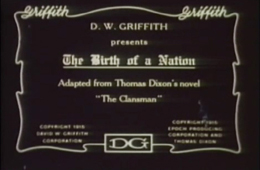Teachers' Domain - Digital Media for the Classroom and Professional Development
User: Preview

Source: The Rise and Fall of Jim Crow: "Fighting Back"
On the evening of March 21, 1915, President Woodrow Wilson attended a special screening at the White House of The Birth of a Nation, a film directed by D.W. Griffith and based on The Clansman, a novel written by Wilson's good friend Thomas Dixon. The film presented a distorted portrait of the South after the Civil War, glorifying the Ku Klux Klan and denigrating blacks. It falsified the period of Reconstruction by presenting blacks as dominating southern whites (almost all of whom are noble in the film) and sexually forcing themselves upon white women. The Klan was portrayed as the South's savior from this alleged tyranny. Not only was this portrayal untrue, it was the opposite of what actually happened. During Reconstruction, whites dominated blacks and assaulted black women. The Klan was primarily a white terrorist organization that carried out hundreds of murders.
After seeing the film, an enthusiastic Wilson reportedly remarked: "It is like writing history with lightning, and my only regret is that it is all so terribly true." African American audiences openly wept at the film's malicious portrayal of blacks, while Northern white audiences cheered. The film swept the nation. Riots broke out in major cities (Boston and Philadelphia, among others), and it was denied release in many other places (Chicago, Ohio, Denver, Pittsburgh, St. Louis, and Minneapolis). Gangs of whites roamed city streets attacking blacks. In Lafayette, Indiana, a white man killed a black teenager after seeing the movie. Thomas Dixon reveled in its triumph. "The real purpose of my film," he confessed gleefully, "was to revolutionize Northern audiences that would transform every man into a Southern partisan for life."
As the NAACP fought against the film and tried unsuccessfully to get it banned, the Ku Klux Klan successfully used it to launch a massive recruiting campaign that would bring in millions of members. Griffith later regretted the racial prejudice that his film promoted. He tried to make amends by making Intolerance, a film attacking race prejudice. But Intolerance never approached the success of The Birth of a Nation.
--adapted from the website The Rise and Fall of Jim Crow
Narrator: In 1915, the Clansman was made into a motion picture Birth of A Nation, The NAACP launched a major campaign to ban it. Violence erupted in many cities where the film played. In Lafayette Indiana, a white man killed a black teenager after seeing the movie. Elsewhere gangs of whites attacked blacks on the streets. And the Ku Klux Klan was reborn.
Thomas Cripps: The one thing about the Birth of a Nation and its link to Ku Klux Klan recruiting is not so much the numerical quantity of it, but rather that ideologically it gave Northerners some form of rhetoric that helped them understand the racism they were already believing anyway.
 Loading Standards
Loading Standards